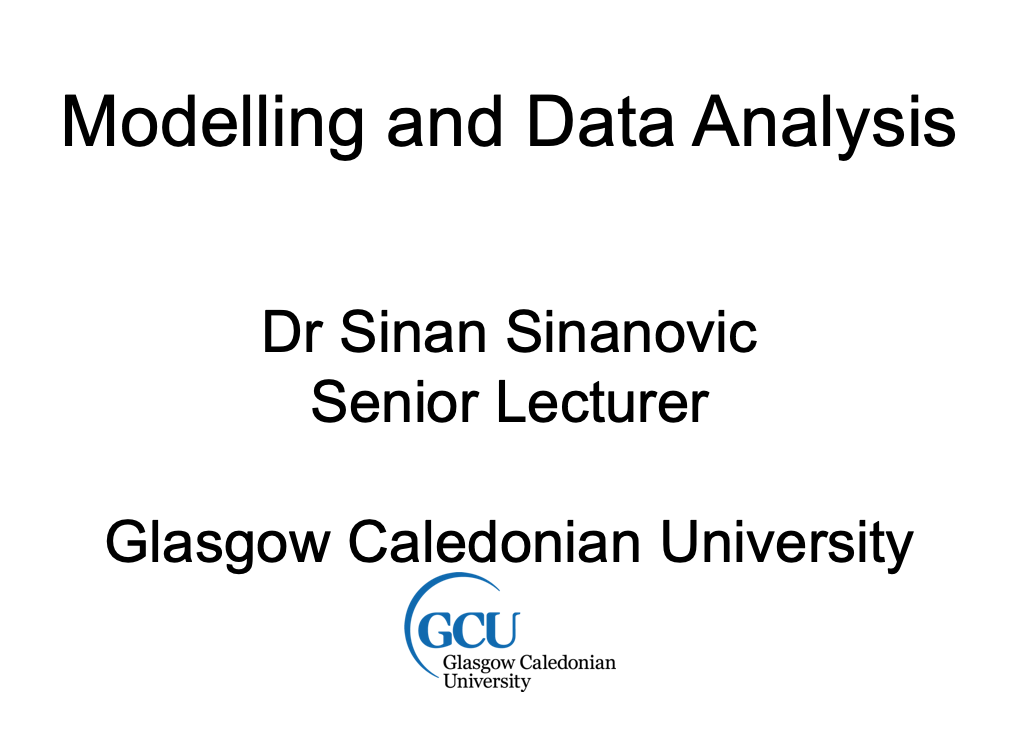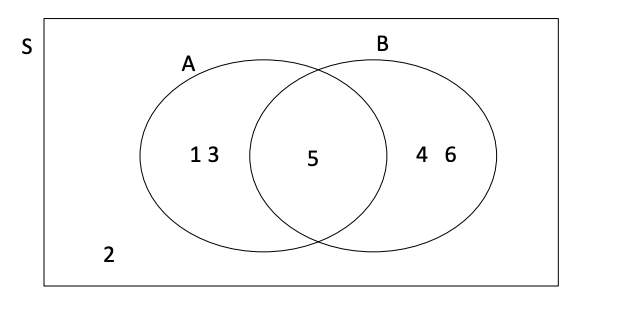-

-
Artificial Intelligence (AI) with MATLAB
• Industry case studies
– Last time: smart grid
• This time: object recognition with deep learning
• Matlab demo, linked below, uses transfer learning to retrain AlexNet, a pretrained deep convolutional neural network (CNN), to recognise foods such as hot dogs, cupcakes, and apple pie.
• https://uk.mathworks.com/videos/deeplearning-with-matlab-transfer-learning-in-10- lines-of-matlab-code-1487714838381.html
Lecture 2
- Venn Diagrams
- Non-Discrete (Continuous) sample space example
- Probability (classical and frequentist approaches)
- Probability Axioms
- Facts about probability: subset fact, range of probability values, empty set, complement probability, probability of a union
-
Venn Diagrams
- Venn diagram: picture which represents the outcomes of an experiment.
It typically consists of a box which represents the sample space S together with circles or ovals.
The circles or ovals represent events.
- Example: experiment has the outcomes S={1, 2, 3, 4, 5, 6} where each outcome has an equal chance of occurring.
Let event A = {1, 3, 5} and event B = {4, 5, 6}.
Then A ∩ B = {5} and A U B = {1, 3, 4, 5, 6}. The Venn diagram is as follows:
Venn Diagram Example
- Venn diagrams are useful to visualise the problem and help the understanding

- Venn diagram: picture which represents the outcomes of an experiment.
-
Continuous sample space example
- Measurements of the weight of a device are modelled with the sample space: S = {x | x > 0}, where S consists of positive real numbers
First set A1 = {x | 10 < x < 13},
Second set A2 = {x | 11 < x < 15}
- Find union of A1 and A2, their intersection andcomplement of A1 and complement of A2.
Solution
• Union: A1 U A2 = {x | 10 < x < 15}
• Intersection: A1 ∩ A2 = {x | 11 < x < 13}
• Complement: A1’ = {x | 0 < x ≤ 10 or x ≥ 13}
• Complement: A2’ = {x | 0 < x ≤ 11 or x ≥ 15} - Measurements of the weight of a device are modelled with the sample space: S = {x | x > 0}, where S consists of positive real numbers
-
Probability
- Random experiments have associated probability with them
- To measure the probability, we assign a number between 0 and 1
− 0 denotes probability that the event will not happen
− 1 denotes probability that event will certainlyhappen
- Example: If event has associated probability of 1/5, it will happen with 20% chance (1/5=0.2) and it will not happen with 80% chance (1-0.2=0.8)
Assigning probability- classical approach
- If an event can occur in e different equally likely ways out of a total number of n possible ways, then the probability of the event is e/n.
- Example: If coin is fair (head and tails are equally likely), probability of obtaining the tail is ½.
- Example: If die is fair (all six outcomes are equally likely), probability of obtaining a three is 1/6.
- Example: If there is one defective chip in 2000, the probability of picking it is 1/2000.
Assigning probability- frequencyapproach
- For a very large number n, after n repetitions of an experiment, an event is observed to occur in e of these, then the probability of the event is e/n.
− Also known as empirical probability of the event- Example: Coin is tossed 1,000 times and head occurred 493 times. Probability of a head is estimated as 493/1000=.493
- Example: Die is tossed 1,000 times and number three is obtained 161 times. Probability of seeing a three is then 0.161
-
Probability axioms
- If S is discrete sample space, all subsets correspond to events
- Real number P(A) is associated with each event A in the space of events, C.
P is a probability function and P(A) is the probability of the event A, if the following axioms are satisfied:
- Axiom 1: For each event A in space C, P(A)≥0
- Axiom 2: For the sure event S in C, P(S)=1
- Axiom 3: For mutually exclusive events A1, A2 12 ... in C, P(A1 U A2 U...) = P(A1)+P(A2)+...
- Axiom 1 is about non-negativity ofprobability
- Axiom 2 is about unitarity – there is an event, entire sample space, which will occur with probability of one
- Axiom 3 is about additivity of mutually exclusive sets
- Rest of facts about probabilities can be derived based on these axioms
- The framework works with any assigned probabilities, as seen next
Probability Axioms: Simple Example
- If we consider a single coin toss, then the coin will show either heads (H) or tails (T).
No assumption is made as to whether the coin is fair
- Sample space S and space of event C are then: S={H,T} and C={Ø,{H},{T},{H,T}}
- Probability of either head or tails is 1: P({H,T})=1
• Sample space S is {H,T} and it is a sure event
- Sum of probability of heads and probability of tails is one: P({H})+P({T})=1
• This is true for both fair and biased coins
- Probability of neither head nor tails is 0: P (Ø)=0
-
Assigning probabilities
- Assigning probabilities provides a mathematical model
- Coin or die examples: assigning equally likely probability to simple events is one way;
Frequency approach, where experiment is performed many times to measure probability empirically, is another
- However, the success of the mathematical model must be tested by experiment just like other theories
Facts about probability
- If A is a subset of B, then the probability of A is less than, or equal to the probability of B
• Monotonicity property: If A is a subset of B, P(A)<P(B)
• Example: Even die tosses are a subset of alltosses, (P(even)=1/2 and P(S)=1)
- Probability is between zero and 1
Bounded values property: 1 ≥ P(A)≥0
• Useful for checking calculations
• If probability is outside of [0,1] interval, calculations are incorrect!
- Probability of empty set is zero
• Empty set property: P (Ø)=0
- Complement probability: P(A’)=1-P(A)
• Example: If probability that device will fail (A) is 0.05, then the probability that it will not fail (A’) is 0.95.
• Example: If probability of obtaining a four in a die toss is 1/6, then the probability of not obtaining a four is 5/6.
• Complement probability is used frequently to 17 simplify/check probability calculations
Facts: examples
- If events A1, A2 , … and An are mutually exclusive and they form sample space S, then
P(A1) + P(A2) + …+P(An)=1
• Example: Probability of heads is ½ and probability of tails is ½. There are no other events: 1/2+1/2=1
• Example: Probability that machine is working is 0.95. Probability that machine is not working is 0.05.
Probability of a Union
- For any two events A and B, the probability of union is given by:
P(A U B) = P(A) + P(B) - P(A ∩ B )
- The reason probability of intersection is subtracted is that it is counted twice, in P(A) and P(B)
- For mutually exclusive events, we get
P(A U B) = P(A) + P(B)
- P(A ∩ B )=0 because intersection is an empty set in this case
Probability of union vs sum of individual probabilities
- Can probability of a union of two sets be larger than the sum of individual probabilities?
- Formally, is it possible to have:
P(A U B) > P(A) + P(B) ?
Answer:
Fact: P(A U B) = P(A) + P(B) - P(A ∩ B )
And P(A U B) > P(A) + P(B) would mean
P(A U B) = P(A) + P(B) - P(A ∩ B ) > P(A) + P(B)
0> P(A ∩ B ) which is impossible
Conclusion: P(A U B) > P(A) + P(B) is NOT possible -
Example
A broken engine is randomly selected from a batch that is classified by faulty part A and faulty part B.
There are 1,000 broken engines, and 30 have faulty part A and 40 have faulty part B, while 20 have both faulty parts.
Find the probability that the engine has at least one faulty part.
- Click here for Solution to the example
Example: Solution
Then P(A) = 30/1000, P(B) = 40/100 and P(A ∩ B ) = 20/1000.
Therefore, P(A U B) = (30+40-20)/1000 = 50/1000 -
Example: Solution
Then P(A) = 30/1000, P(B) = 40/100 and P(A ∩ B ) = 20/1000.
Therefore, P(A U B) = (30+40-20)/1000 = 50/1000